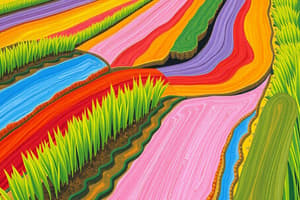Podcast
Questions and Answers
What percentage of the calories consumed by humans annually does rice contribute to?
What percentage of the calories consumed by humans annually does rice contribute to?
- 20% (correct)
- 5%
- 10%
- 30%
Where was Asian rice believed to have originated?
Where was Asian rice believed to have originated?
- China (correct)
- Korea
- Japan
- India
When was African rice domesticated?
When was African rice domesticated?
- 4,000 years ago
- 3,000 years ago (correct)
- 2,000 years ago
- 1,000 years ago
What is a traditional rice farming method that returns high yields but is water-intensive?
What is a traditional rice farming method that returns high yields but is water-intensive?
What contributes around 12% of human-caused methane emissions each year?
What contributes around 12% of human-caused methane emissions each year?
What management strategy is being explored to reduce methane emissions and water use in rice cultivation?
What management strategy is being explored to reduce methane emissions and water use in rice cultivation?
Rice contributes to over 20% of the calories consumed by humans annually.
Rice contributes to over 20% of the calories consumed by humans annually.
African rice is mostly limited to East Africa today.
African rice is mostly limited to East Africa today.
South American rice was lost after the arrival of Europeans.
South American rice was lost after the arrival of Europeans.
Rice is a fully aquatic plant that can only grow in specific climates.
Rice is a fully aquatic plant that can only grow in specific climates.
Rice cultivation contributes around 12% of human-caused methane emissions each year.
Rice cultivation contributes around 12% of human-caused methane emissions each year.
Asian rice was the first to be domesticated around 5,000 years ago.
Asian rice was the first to be domesticated around 5,000 years ago.
Rice farming methods that involve planting in paddy fields are not water-intensive.
Rice farming methods that involve planting in paddy fields are not water-intensive.
Researchers and growers are not exploring water management strategies to reduce methane emissions and water use in rice cultivation.
Researchers and growers are not exploring water management strategies to reduce methane emissions and water use in rice cultivation.
Study Notes
- Rice is a staple food for over 3 billion people, contributing to over 20% of the calories consumed by humans annually.
- The origins of rice date back thousands of years to Asia, Africa, and South America, where farmers independently domesticated the crop.
- Asian rice, believed to have originated in China, was the first to be domesticated around 10,000 years ago, leading to the formation of farming communities.
- African rice, domesticated around 3,000 years ago, is mostly limited to West Africa today.
- South American rice was also domesticated around 4,000 years ago but was lost after the arrival of Europeans.
- Asian rice spread widely and is now a cornerstone of diet and culture in Asia and beyond.
- Rice is a semi-aquatic plant that can grow in many climates and in submerged soils, making it a popular crop for farmers.
- Traditional rice farming methods involve planting in paddy fields that are submerged in water throughout the growing season, which returns high yields but is water-intensive and contributes to significant methane emissions.
- Rice cultivation contributes around 12% of human-caused methane emissions each year due to the growth of methanogens in flooded paddy fields.
- Researchers and growers are exploring water management strategies, such as alternate wetting and drying, to reduce methane emissions and water use while maintaining yield.
Studying That Suits You
Use AI to generate personalized quizzes and flashcards to suit your learning preferences.
Description
Explore the origins, spread, and impact of rice cultivation across Asia, Africa, and South America. Learn about traditional farming methods, environmental implications, and ongoing research in rice cultivation.




